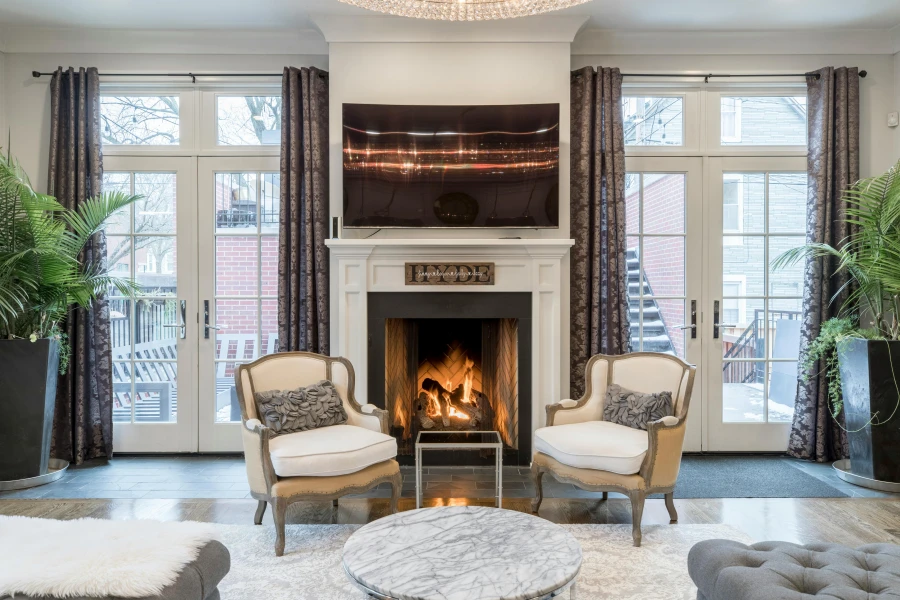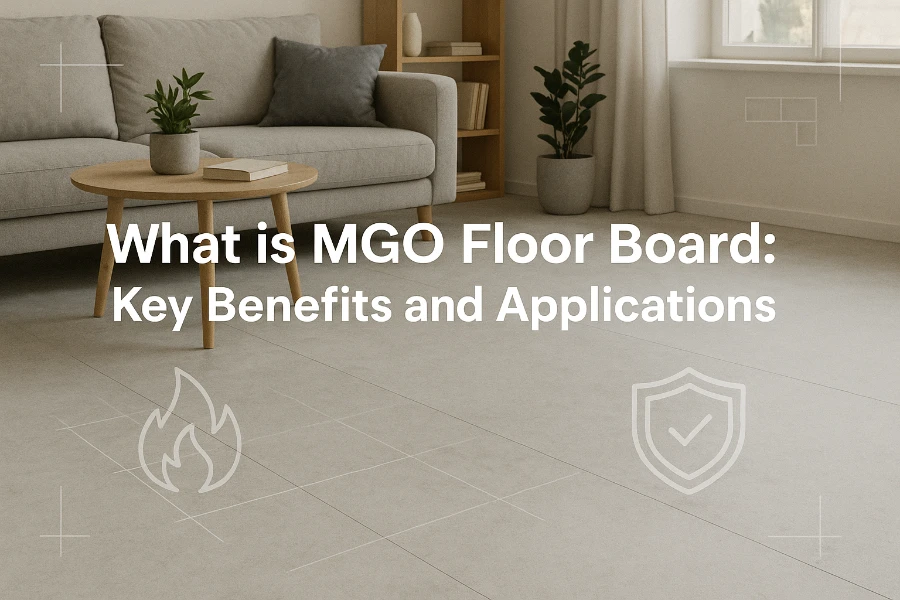Table of Contents
Ask Us Any Question
1. Introduction
Australia’s construction industry increasingly demands fire-resistant, durable, and environmentally friendly building materials. Magnesium Oxide Board (MgO board) is emerging as a preferred choice for builders and designers across residential and commercial projects. Whether for homes, apartments, or commercial buildings, MgO board provides reliable fire protection while also offering moisture resistance, dimensional stability, and ease of installation.
2. What is Magnesium Oxide (MgO) Board?
Magnesium Oxide Board, commonly known as MgO board, is a high-performance building material made primarily from magnesium oxide, magnesium chloride (or magnesium sulfate), and reinforcing fibers. It is renowned for its fire-resistant, water-resistant, and durable properties, making it suitable for a wide range of construction applications. Unlike traditional gypsum or cement boards, MgO boards are non-combustible, mold-resistant, and environmentally friendly. They provide a safe and long-lasting solution for walls, ceilings, flooring underlayment, and other areas where high heat or moisture resistance is required.
With a smooth surface and versatile finishing options, MgO boards can be painted, tiled, or plastered, giving designers and builders flexibility without compromising safety or durability. Additionally, MgO board is easy to cut and install, reducing labor time and project costs while maintaining excellent long-term performance. These features make it an ideal solution for Australian construction projects, where fire safety, moisture resistance, and sustainability are highly valued.
3. Why MgO Board is Ideal for Australian Construction
3.1 Fire Resistance in Bushfire-Prone Areas
Australia frequently faces bushfires, particularly in regions such as Victoria, New South Wales, and Queensland. In these areas, fire-resistant building materials are essential. MgO board is non-combustible, maintaining structural stability under high temperatures. It can withstand temperatures above 1000°C for a short period without structural failure, which is crucial in protecting homes and commercial properties.
Builders in bushfire-prone regions use MgO boards for external walls, ceilings, and eaves, significantly reducing fire risk. Using MgO board can also contribute to lower insurance premiums due to its proven fire-resistant performance. Architects and designers increasingly specify MgO board in construction plans, ensuring both compliance with Australian fire safety standards and peace of mind for property owners.
3.2 Durability Against Moisture and Harsh Climates
Australia’s diverse climate, from humid coastal cities to arid inland regions, demands building materials that can withstand extreme conditions. MgO board is moisture resistant, dimensionally stable, and resistant to cracking, making it suitable for both interior and exterior applications.
In cities like Sydney, Brisbane, and Perth, high humidity can damage traditional gypsum boards. MgO board retains its shape and performance even under moisture exposure, making it ideal for bathrooms, kitchens, laundry rooms, and wet-area wall applications. For coastal and tropical regions, MgO board can be used in exterior cladding, window surrounds, and roofing areas, resisting deterioration from rainfall, humidity, and storms. Its high compressive strength ensures long-term structural stability, providing a reliable solution for Australian builders dealing with diverse environmental conditions.
3.3 Non-Toxic and Environmentally Friendly
MgO board is made from natural materials and contains no harmful chemicals, making it safe for indoor environments. It does not release toxic gases in case of fire and is free from asbestos, formaldehyde, or heavy metals, which may be present in some traditional building materials.
Additionally, MgO board is recyclable and has a lower carbon footprint during production compared to cement or gypsum boards, making it a sustainable choice for environmentally conscious projects. Using MgO boards in schools, hospitals, and residential buildings improves indoor air quality, contributing to healthier living and working environments. Builders can also leverage its sustainability to achieve Green Star or NABERS rating standards, aligning with Australia’s increasing emphasis on green construction.

4. Applications of MgO Board in Australia
4.1 Residential Construction
In Australian homes, MgO board is commonly used for interior walls, ceilings, and flooring underlayment. Its fire-resistant properties provide essential protection in bushfire-prone regions, while its moisture-resistant and durable characteristics make it ideal for bathrooms, kitchens, and laundry areas.
MgO board serves as a backing material for tiles, paint, or decorative finishes, offering both practicality and design flexibility. Homeowners and builders appreciate its long-lasting performance, low maintenance requirements, and versatility. Its ability to withstand temperature fluctuations, humidity, and minor impacts makes it a superior choice compared to gypsum or cement boards for residential projects across Australia.
4.2 Commercial Construction
For commercial projects such as offices, hotels, shopping centers, and public facilities, MgO board provides a reliable and efficient building solution. Its non-combustible and strong properties ensure compliance with Australian building codes, particularly regarding fire safety and structural integrity.
Builders often use MgO board for partition walls, ceiling panels, and cladding systems, benefiting from quick installation and long-term durability. Commercial clients also value MgO board’s aesthetic versatility, as it can be painted, laminated, or tiled without losing its strength. This combination of performance and flexibility makes it a preferred material for large-scale Australian projects where safety, efficiency, and durability are critical.
4.3 Special Projects and Prefabricated Buildings
Australia has a growing demand for prefabricated homes and modular construction, and MgO board is ideal for these applications. Its lightweight, strong, and easy-to-cut characteristics make it highly compatible with prefabricated wall panels and modular units.
MgO board maintains its heat, moisture, and impact resistance during transport and installation, ensuring prefabricated buildings remain safe, durable, and visually appealing. Architects and builders can meet project-specific requirements without compromising on quality or performance. This versatility allows MgO board to be used in a wide range of special projects, from modular offices to temporary structures, meeting both safety standards and aesthetic goals.
5. Installation and Compliance in Australia
5.1 Recommended Thickness and Standards
Choosing the correct MgO board thickness is essential for both structural integrity and fire resistance. For interior walls and ceilings, boards ranging from 9mm to 12mm are typically recommended, while exterior applications or high-impact areas may require 12mm to 15mm. Selecting the proper thickness ensures compliance with Australian building standards and optimal performance in fire resistance, durability, and sound insulation.
For flooring underlayment, 18mm boards are preferred, offering strength, stability, and smooth finish for tiles, vinyl, or timber installations.
5.2 Compatibility with Local Building Codes
MgO board fully complies with Australian building codes, including fire safety, moisture resistance, and structural performance requirements. Builders should ensure installation aligns with Australian Standards (AS/NZS) and local regulations. Proper installation by trained professionals ensures compliance, safety, and long-term durability, meeting the requirements of insurance policies and building inspections.
5.3 Tips for Long-Lasting Performance
To maximize MgO board performance in Australian conditions:
-
Store boards in a dry, ventilated area before installation to prevent moisture absorption.
-
Use appropriate fasteners and adhesives recommended by the manufacturer.
-
Seal joints properly to maintain fire resistance and structural stability.
-
Avoid prolonged exposure to water until finishing materials, such as paint or tiles, are applied.
-
For external applications, consider protective coatings or paint to enhance weather resistance.
Following these practices ensures long-term durability, fire safety, and low maintenance, making MgO board a reliable choice for Australian construction projects.
6. Advantages of MgO Board Over Other Materials in Australia
6.1 Compared with Cement Boards
Cement boards are often used for wet areas and exterior walls, but MgO board offers advantages including lighter weight, easier handling, and quicker installation. Its dimensional stability reduces the risk of cracking or warping over time, while superior fire resistance makes it safer in bushfire-prone areas.
6.2 Compared with Gypsum Boards
Gypsum boards are popular for interior walls and ceilings but perform poorly in high-moisture or high-temperature environments. MgO board excels in these conditions, maintaining structural integrity, durability, and fire safety. Unlike gypsum, MgO boards resist swelling, deterioration, and mold growth, making them ideal for kitchens, bathrooms, and laundry areas in Australian homes and commercial projects.
6.3 Cost-Effectiveness and Value
MgO board balances high performance with competitive pricing. Although initial costs may be slightly higher than gypsum boards, the long-term benefits—including durability, low maintenance, fire safety, and versatile applications—make it cost-effective. Builders and homeowners save on repair costs, insurance premiums, and replacement materials, achieving a high return on investment while ensuring safety and quality.
7. Conclusion
In conclusion, Magnesium Oxide (MgO) Board is an ideal building material for Australian construction due to its fire-resistant, durable, moisture-resistant, and environmentally friendly properties. Suitable for residential homes, commercial buildings, and prefabricated projects, MgO boards provide long-lasting performance and peace of mind for builders and homeowners alike.
Compared to traditional cement or gypsum boards, MgO boards offer superior safety, stability, and versatility, while delivering excellent value over the long term. Proper installation and compliance with Australian building codes ensure the highest standards of quality.
For Australian builders, designers, and property owners seeking a reliable, safe, and sustainable construction solution, MgO board represents the smart choice. Contact us today for pricing, samples, and technical support to learn how MgO boards can enhance your next project.
Discover if Magnesium Oxide Board (MgO Board) can be safely used around fireplaces. Learn about fire resistance, heat safety, and proper installation.
High-performance MGO floor board: fire-resistant, moisture-proof, durable, and eco-friendly. Discover key benefits, applications, and installation tips today.
Discover why builders love MgO wall board for its fire resistance, durability, and eco-friendliness. Learn applications, benefits, and installation tips.




